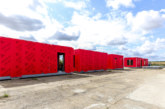Ben Farrar, Market Development Manager, Traka UK, looks at the effects of the pandemic and the recovery period from the perspective of the NHS. He suggests now is a pivotal moment, where local authorities can utilise innovative technology and support services to coordinate an intensive period of positive transformation for the benefit of staff and patients.
Since its inception the NHS has gone through many changes, improvements, updates and modernisation processes, all with an aim to deliver its vision to provide good, strong and reliable healthcare for all.
No-one back in 1948 would have been able to foresee the way in which the NHS developed, succeeded, pioneered and expanded, culminating in its impressive handling of the global pandemic in 2020 and 2021, with NHS workers presenting as a “miracle,” “magic” and “having superpowers.” Health Secretary Sajid Javid highlighted “the incredible work they have been doing throughout the pandemic.”
As local authorities look for support to recover, in a recent speech made by the Department for Health and Social Care, it was stated, “now is the time to fulfil our duty to the 130,000 who have died — and the millions who have suffered or been bereaved by COVID” to “make this a turning point from which we build the best health system in the world.”

Demand, Resources and Innovation
There are three areas that local authorities need to support NHS teams to recover, with Mr Javid offering, “everything they need during this time, especially as we look forward to dealing with the backlog as well, even when we get past the worst of the pandemic.”
Coping with NHS workforce fatigue and morale, meeting demand, especially with the elective backlog, and gaining resources are all highlighted as essential to sustainability. But key to success, innovation has been seen as being ‘unleashed by the pandemic and embraced by the workforce.’
Innovation includes transformation of NHS Estates. In the heart of the pandemic, NHS Open Space launched 40 new sites in September 2020, providing flexible clinical and meeting space on a pay-as-you-go basis. The scheme represents a step change in how we think about the NHS estate, and will also generate additional funds that can be reinvested back into the health service.
Technology has also been factored into the design of new schemes, with motion sensors in some rooms to monitor space usage and help improve efficiencies. While it’s true that this is a fairly humble application of technology, it still signifies a promising shift towards designing digital technologies into the way in which we use and optimise our healthcare spaces.
The Department for Health and Social Care is looking to empower NHS teams “to deliver the best care they can through the best data architecture,” with use of technology and intelligent asset management to ensure essential medical information, drugs and resources are instantly and efficiently available to authorised personnel as required to deliver exceptional care.

Brighton & Hove Sussex NHS Trust
Brighton and Sussex NHS Trust is one example of how healthcare facilities are making changes and use of innovative resources such as key management, embedding the technology into its health, safety and security procedures. The Trust itself highlighted its own agenda, with a dedicated ‘Patient first programme,’ supported by five pillars, each designed to help achieve its vision. The first is about getting front-line staff to approach problem solving and root cause analysis from a different, ceaselessly inquisitive perspective.
Traka worked with staff to improve the safety and accountability of the drugs issuing process at Brighton and Sussex NHS Trust, by installing its key management solutions. Previously, keys to drugs lockers were issued manually, with one member of staff acting as a steward. However, this led to human error, difficulties in locating the keys and additional administration duties for busy ward staff.
After working with Traka, the keys to the drug lockers are stored within an intelligent key cabinet. Through the ward staff’s existing credentials, only authorised personnel are able to access the cabinet. The keys inside the system are also locked in place by Traka’s secure iFobs, which means a hierarchy of access rights can be given to each key, depending on the strength or skill of administrating each drug. Within the cabinet, only certain keys will be available depending on the pre-determined access rights.
To maximise security, the key cabinet has been programmed so that two members of staff need to swipe their credential to take and to return a key to the system. This creates greater efficiencies, accountability and encourages an easy-to-achieve ‘working together’ culture and best practice amongst ward staff.

Looking to the future
“Imagine an NHS in which you can access right data, the right information, at the right time with the touch of a button, as easily as you can check the weather on your phone.”
This is the vision highlighted by The Department of Health to work on a local authority basis to achieve. Whilst the NHS has faced countless challenges in its 73-year history, at no time has it experienced, “possibly the greatest wave of innovation in the history of our NHS that is going on right now.”
Whilst elements such as Traka key and asset management represent just one component to enhancements being made to NHS estates, it paves the way to opening up our healthcare workers to greater efficiencies, transparent working practices and encourages collaborative use of resources.
Such integration of the right technology represents a prime opportunity to realise the Department for Health and Social Care’s vision for a “world-leading technology- and data-driven health and social care system.” One that is available for all to access. It also helps work towards an aim to “fulfil the NHS’s potential to be the best health service in the world.”
Traka’s white paper, entitled ‘Embracing change for our NHS and UK Healthcare,’ is now available to download at https://systems.traka.com/white-papers/healthcare









